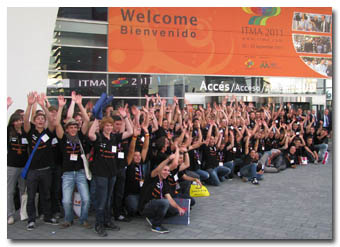LUBBOCK, Texas — October 24, 2011 — The Institute of Environmental and Human Health (TIEHH) at
Texas Tech University has made history for the Technical Association of Pulp and Paper Industry’s
(TAPPI) nonwovens division due to the university’s involvement of high school students in its
cotton nonwovens research.
Kahan Chavda, a senior from St. Mark’s School of Texas in Dallas; Aarav Chavda, a junior from
St. Mark’s School of Texas; Ronald Kendall Jr., a senior from Lubbock Coronado High School; and
Luke Kitten, a senior from Lubbock Trinity High School, participated in the research.
The research from these high school students contributed to the work on oil absorption by
cotton nonwovens and was presented at the leading nonwovens conference in Atlanta.
“This is a very significant achievement,” said TAPPI President Larry Montague. “To my
knowledge this is the first time that high school students were specifically targeted and brought
to an event like TAPPI.”
The students not only attended the conference but also participated in the program sessions,
as well as interacted with professionals already working in the nonwovens industry.
“In the five years I have been with TAPPI, I have not seen a group like this prior to TIEHH’s
outreach program,” Montague said. “The attendees for this conference were very impressed with how
these students dressed and interacted with some of the industry’s best and brightest.”
TIEHH’s research focuses on West Texas cotton, specifically the 10 percent of cotton that,
due to the weather in the region, doesn’t fully mature and must be sold at a discounted rate.
“What our lab thought two years back was why can’t we take this discounted cotton and find
new market opportunities for that cotton,” said Seshadri Ramkumar, associate professor of nonwoven
materials and countermeasures to chemical threats.
Vinit Singh, a graduate student at Texas Tech, found that the discounted cotton absorbs more
oil than higher quality cotton, and to prove that he enlisted the help of the high school students
to assist in conducting research.
Utkarsh Sata, a postdoctoral associate in Ramkumar’s laboratory guided Chavda brothers this
summer to find added applications for cotton nonwovens.
“I became interested in it a few years back when Fibertect® started getting some
recognition,” Kendall said. “I get to do some cool things out here which makes it fun to talk about
with people and gets some of my fellow classmates interested in it.”
Kendall and Kitten still are actively involved in the research. Kitten battled Lymphoma
during his participation in the research.
He said doing research out at TIEHH allowed him the opportunity to take his mind off the
treatments.
“Going to treatments affected my schedule a lot,” Kitten said. “I missed a lot of school and
work going to treatments. But everyone here has been very helpful and very supportive.”
Kendall and Kitten are currently investigating the oil absorption capabilities of the 2011
cotton crop.
“Ramkumar’s research has and is a crucial part of making the world more aware of this
fascinating industry,” Montague said. “Just about the time we think we have heard it all before, a
press release comes out from Texas Tech, with another winning research project that has resulted in
a new product line.”
Posted on October 25, 2011
Source: Texas Tech University





